Portrait of the Artist: Lisa Stefanelli
“Portrait of the Artist” is a series by photographer Claudine Williams. The Q&As are with people in the arts and culture industry — actors, musicians, painters, writers — with photos to suit each artist.
Lisa Stefanelli is an abstract artist, a painter and sculptor, practicing in Tribeca and Easton, Pennsylvania. She also founded and ran Barre TriBeCa for several years on Warren Street. She lives here with her husband and three children.
Tell me about your art and how did you get started in that business?
My art practice has always been with me. I began as a young artist trying to make sense of the world. Now when I see what the world offers, I look at it much differently. This shift in perspective seems to have taken a certain “chronological status” to achieve. At a certain age I was able reach an understanding with the world in which we live. I was no longer afraid.
Up until the birth of our children, and possibly the death of my parents, I felt somewhat at the world’s mercy. This is no longer the case. It became very obvious to me that one day we will no longer be here. We should focus on the offerings this life has for us. We should remain grateful, and above all try to maintain a sense of humor.
Business and art do not happily coexist in the studio. The process of making art can fall under the influence of the business of selling it. Success in business is how we measure success in this world and let’s face it, we all want to feel “successful” to some degree. This can interfere with making art if not kept in check.
What is the most satisfying part of your work?
The best part of having an artist’s practice is knowing that there is always a place to be with your concerns. Being an artist is a blessing like no other. As an artist you have a place, a very specific place, where you can be simultaneously ecstatic or sad. It’s a place where you can rejoice and mourn. It’s very simple, yet very complex.
Anything new from Lisa Stefanelli, artist, that we should know about?
Everything is new.
My art is about our attempts to coexist within the complexities we live in. Relationships with other people, other communities, nations, mentalities and the peace and conflict within these things. In my art, this can be quite literal For instance, the trajectories of lines might imply the path an individual is on, and it intersects with other lives, and other paths, all individual, but contributing to one entire dialogue, or one complexity, or one big beautiful piece of art.
Now I pursue the observation of these relationships by stepping outside of myself, rather than approaching them from within. I care more about the world now and feel as though as an artist I am contributing. I’m no longer afraid of it.
How long have you been in Tribeca? How did you wind up here?
I’ve been here since ‘91. After Rhode Island School of Design, I came to “The City.” I’m originally from New Jersey and that’s what we people from New Jersey called Manhattan.
I had an uncle who lived in “The City.” He used to tell me about when he was a young boy and how he would look out across New Jersey and see the skyline and think to himself: “12 miles and 50 million light years.” I felt that. The city was like a life raft on the ocean. I only needed to learn how to swim to it.
After I finished in Providence, I stayed in my uncle’s apartment on East 72nd while working for the Woo brothers and their film production company in Chelsea. Many of the young people who worked at Woo Art had lofts in TriBeCa, and I became familiar with the neighborhood. Eventually I found my way to Franklin and Washington streets where I sofa-surfed with friends. This was in ’93. I stayed often with a friend in a loft on Franklin across from the then Nobu and next door to a then empty firehouse. G Love and Special Sauce were on the 2nd floor. We shot music videos in the basement of buildings on Washington Street (Black Sheep). I parked my car for weeks at a time on Laight Street, shopped at Belle Bates and passed up buying a loft on Franklin for $250,000.
My husband, whom I hadn’t met yet, was living around the corner with his then girlfriend. On Christmas night in ‘96 we met at the bar at Yaffa’s. Both of us had a dream of living and owning an apartment in Tribeca and that dream came true eventually.
Any favorite local businesses that you’d like to give a shout out to?
The Zlotnikov family’s bin store at 28 Warren. Without the support and generosity of The Zlotnikov’s I would have encountered a lot of difficulty maintaining my studio practice. Reform Club, for fitness, in the former Barre TriBeCa Space also at 28 Warren. Bob Townley’s Manhattan Youth. It used to be a shack on the pier. Morgan’s Market. Let’s keep them alive…don’t forget to go by and get your milk there rather than Target when possible.
What is a typical weekend like for you and your family?
Ultimately, our weekends are about parenting our three young children (did I mention we have triplets?). Hearing their voices, listening to their conversations, answering their questions and simply being in the presence of our children is what our weekends are like.
Agnes Martin said that raising a child is the greatest work of art one can ever accomplish, and I agree.







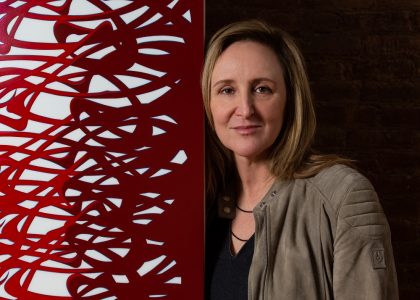
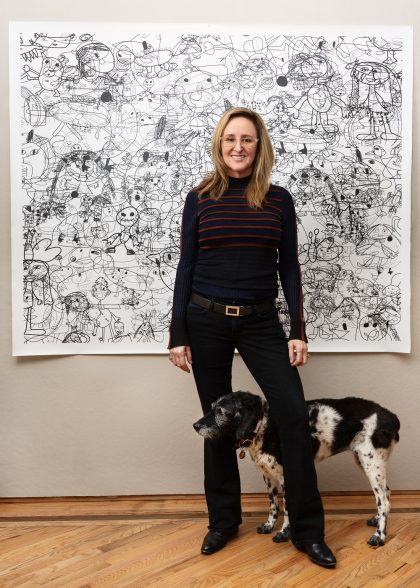
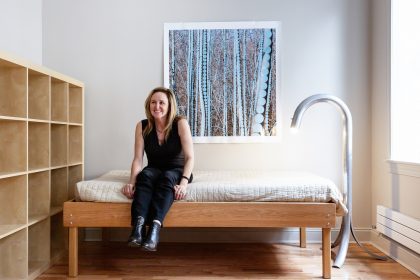
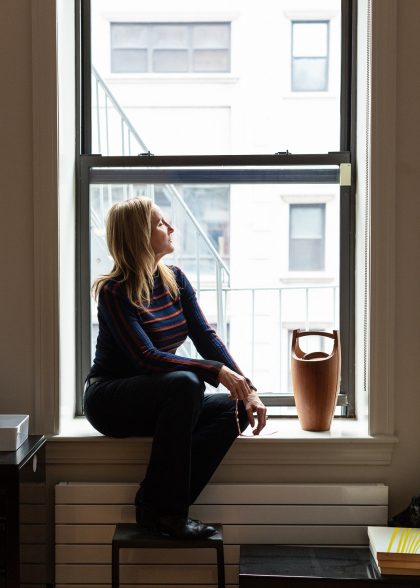
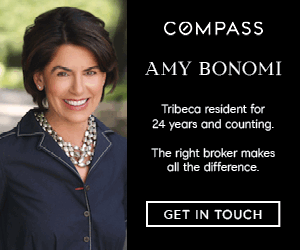






Nice Agnes Martin quote. Nice read. Triplets must keep things lively.
Nice feature on Lisa. Appreciate her shout out to the Zotnikovs at 28 Warren. That building has had many artists (including myself) working there for years.Their store is the last remaining “bargain” store on a street that was once filled with them: a bit of old Tribeca.